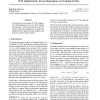246 search results - page 13 / 50 » Learning behavior styles with inverse reinforcement learning |
IJCNN
2006
IEEE
14 years 1 months ago
2006
IEEE
— Biped robots based on the concept of (passive) dynamic walking are far simpler than the traditional fullycontrolled walking robots, while achieving a more natural gait and cons...
LWA
2007
13 years 9 months ago
2007
Typical conversational recommender systems support interactive strategies that are hard-coded in advance and followed rigidly during a recommendation session. In fact, Reinforceme...
ICML
2008
IEEE
14 years 8 months ago
2008
IEEE
We discuss how the runtime of SVM optimization should decrease as the size of the training data increases. We present theoretical and empirical results demonstrating how a simple ...
JMLR
2010
13 years 2 months ago
2010
With the goal to generate more scalable algorithms with higher efficiency and fewer open parameters, reinforcement learning (RL) has recently moved towards combining classical tec...
IROS
2007
IEEE
14 years 2 months ago
2007
IEEE
— Multi-agent systems (MAS) are a field of study of growing interest in a variety of domains such as robotics or distributed controls. The article focuses on decentralized reinf...

